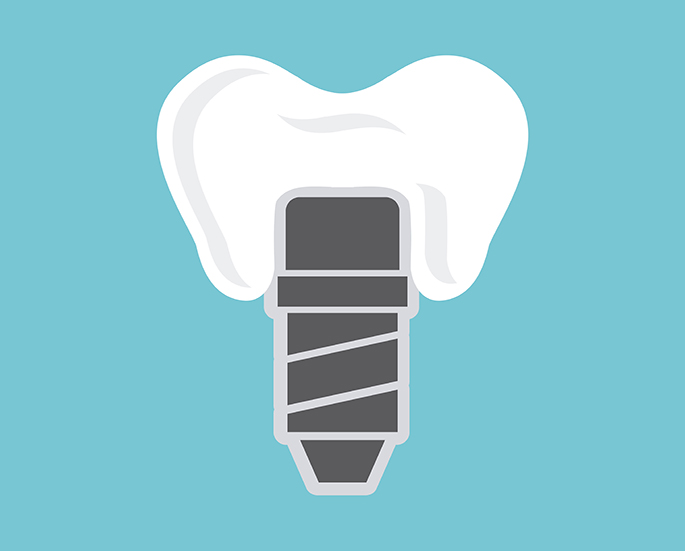Athletics, adventure, age, and/or inconsistent personal dental care – there are many things that may have left you with a missing tooth (or teeth). There is also little else that can make you feel more self-conscious than an empty space where a big, bright, and complete smile should be. Thankfully in modern dentistry can provide patients with solutions that accommodate most timelines, budgets, and preferences, but all alternatives are not created equal and not everyone is a candidate for each. Read further to find out what you can do if you have missing teeth.
5 Options for Replacing a Missing Tooth or Missing Teeth
1. Bridges
Traditionally, a bridge would be recommended if you had only lost one or two teeth. However, the teeth surrounding the area must be healthy and strong and abundant enough to support the artificial teeth creating the bridge. This would have been commonly used for those with a clean bill of dental health yet suffered an impact that knocked-out a tooth (or two). The porcelain or metal bridge is created by book-ending the false tooth with two permanent (lasts on average for about 11 years) crowns, which are capped onto the natural teeth on either side of the gap. The false tooth is cemented into place by this bookend, or bridge. An alternative to the crowns does exist, and is know as an adhesive bridge, which instead bonds the back of the supporting teeth with wings (as opposed to crowning the tops) to create the bridge.
2. Temporary Dentures
Patients may find themselves in a situation where it can take months for their gums and jaw to heal after their teeth have been removed. This is where temporary dentures are prescribed until such time comes for a permanent full-set. The creation of temporary dentures may require four to five dental visits prior to tooth extraction. The good thing about temporary dentures is that they can be fitted and worn on the same day that natural teeth have been removed. This is a short-term solution for patients, allowing them to go about their day to day (eating, socializing, etc.) without the embarrassment and inconvenience.
3. Partial Dentures
Partial dentures, are traditionally suitable for patients needing to replace one or more teeth. Partial dentures, unlike full dentures (below) depend upon the support of the remaining natural teeth in that jaw and the ridge of a patient’s gums and underlying jawbone. This solution includes a dental plate (plastic or metal), fixed into place by metal clasps, that includes sections of porcelain (or plastic) false teeth on them to fill the necessary spaces.
4. Complete Dentures
When there are no teeth left in the upper and/or lower jaw, a full-set of dentures is required. The appliance involved includes a metal or plastic plate framework complete with plastic or porcelain teeth. When dentures are required for the upper jaw, the entire palate is affixed to the dentures via the suctioning effect created between a patient’s saliva and the dentures. There is a little conscious effort required of the patient in the beginning, as they grow accustomed to keeping the dentures in firm place using muscles in the mouth area and by pressing the framework with their tongue. After awhile it becomes second nature. Compared to the upper dentures, a full-set lower dentures are a little less bothersome because they don’t require as much conscious balancing between a patient’s lower cheeks and tongue. Again, this also becomes second nature given enough time.
5. Dental Implants

Dental implants are an ideal solution for replacing a missing tooth or multiple teeth. It curbs bone loss in the jaw and promotes better oral hygiene.
There is some very good news for those looking to replace one or more of their teeth. Gone are the days of bridges and partial dentures being the only recourse. The technological strides in dental implants over the last ten years has opened up effective, timely, aesthetically pleasing, and financially viable alternatives to the traditional methods used to replace teeth.
The dental implant is a titanium synthetic post that is surgically inserted into a patient’s jawbone, replacing the root of the natural tooth that once existed. With the implant root in place serving as an anchor, an artificial tooth (or teeth) is firmly attached to it. The result is a completely natural looking and feeling tooth (or teeth) that will minimize future bone-loss and improve your overall dental health when accompanied by daily care and routine check-ups.
Are you a candidate for a dental implant? If you maintain healthy gums and have enough bone in your jaw to adequately hold an implant you most likely qualify. In the event that your jawbone is currently inadequate, a bone-graft procedure can be considered after a thorough consultation with your dentist. Additional information on taking the next step towards receiving dental implants, including cost and timeline, can be found here or by contacting our dental care centre (for Point Grey, UBC, and Kitsilano area residents).


